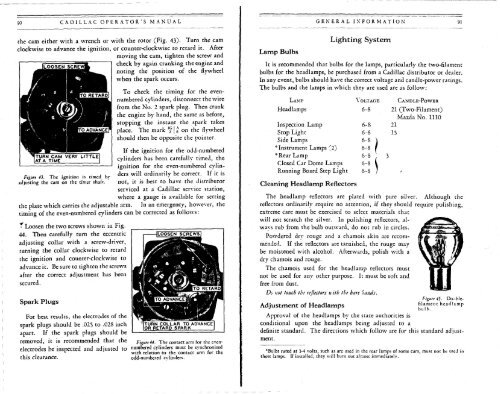1928 Cadillac - GM Heritage Center
1928 Cadillac - GM Heritage Center
1928 Cadillac - GM Heritage Center
Create successful ePaper yourself
Turn your PDF publications into a flip-book with our unique Google optimized e-Paper software.
90 CADILLAC OPERATOR'S MANUAL<br />
the cam either with a wrench or with the rotor (Fig. 43). Turn the cam<br />
clockwise to advance the ignition, or counter-clockwise to retard it. After<br />
moving the cam, tighten the screw and<br />
check by again cranking the engine and<br />
noting the position of the flywheel<br />
when the spark occurs.<br />
(TURN CAM VERY LITTLE<br />
[ATA TIME<br />
Figure 4}. The ignition is timed by<br />
adjusting the cam on the tinier shaft.<br />
To check the timing for the evennumbered<br />
cylinders, disconnect the wire<br />
from the No. 2 spark plug. Then crank<br />
the engine by hand, the same as before,<br />
stopping the instant the spark takes<br />
place. The mark 'f | £ on the flywheel<br />
should then be opposite the pointer.<br />
If the ignition for the odd-numbered<br />
cylinders has been carefully timed, the<br />
ignition for the even-numbered cylinders<br />
will ordinarily be correct. If it is<br />
not, it is best to have the distributor<br />
serviced at a <strong>Cadillac</strong> service station,<br />
where a gauge is available for setting<br />
In an emergency, however, the<br />
the plate which carries the adjustable arm.<br />
timing of the even-numbered cylinders can be corrected as follows:<br />
^Loosen the two screws shown in Fig.<br />
44. Then carefully turn the eccentric<br />
adjusting collar with a screw-driver,<br />
turning the collar clockwise to retard<br />
the ignition and counter-clockwise to<br />
advance it. Be sure to tighten the screws<br />
after the correct adjustment has been<br />
secured.<br />
Spark Plugs<br />
For best results, the electrodes of the<br />
"•-?<br />
spark plugs should be .025 to .028 inch TURN COLLAR TO ADVANCE<br />
OR RETARD SPARK<br />
apart. If the spark plugs should be<br />
removed, it is recommended that the Fi gun 44. The contact arm for the evenelectrodes<br />
be inspected and adjusted to numbered cylinders must be synchronized<br />
r<br />
with relation to the contact arm for the<br />
this clearance.<br />
odd-numbered cylinders.<br />
4 A<br />
\<br />
ll A^rM -Rrprw^l<br />
J/' -r {"%, «»* ^(<br />
r • ,>*1fa. ' :^~ \ '"••<br />
% • * X •<br />
. Oat-.- >*x 8 fc* * ,,j<br />
4^ /#;% , %#<br />
1> +WW*- fc « 6<br />
^x^ .\gr BEEsnas<br />
Lamp Bulbs<br />
GENERAL INFORMATION 91<br />
Lighting System<br />
It is recommended that bulbs for the lamps, particularly the two-filament<br />
bulbs for the headlamps, be purchased from a <strong>Cadillac</strong> distributor or dealer.<br />
In any event, bulbs should have the correct voltage and candle-power ratings.<br />
The bulbs and the lamps in which they are used are as follow:<br />
LAMP<br />
VOLTAGE<br />
Headlamps 6-8<br />
Inspection Lamp 6-8<br />
Stop Light 6-8<br />
Side Lamps 6-8 \<br />
* Instrument Lamps (2) 6-8 I<br />
* Rear Lamp 6-8 3<br />
Closed Car Dome Lamps 6-8 I<br />
Running Board Step Light 6-8 / '<br />
Cleaning Headlamp Reflectors<br />
CANDLE-POWER<br />
21 (Two-Filament)<br />
Mazda No. 1110<br />
21<br />
15<br />
The headlamp reflectors are plated with pure silver. Although the<br />
reflectors ordinarily require no attention, if they should require polishing,<br />
extreme care must be exercised to select materials that<br />
will not scratch the silver. In polishing reflectors, always<br />
rub from the bulb outward, do not rub in circles.<br />
Powdered dry rouge and a chamois skin are recommended.<br />
If the reflectors are tarnished, the rouge may<br />
be moistened with alcohol. Afterwards, polish with a<br />
dry chamois and rouge.<br />
The chamois used for the headlamp reflectors must<br />
not be used for any other purpose. It must be soft and<br />
free from dust.<br />
Do not touch tin reflectors uith the bare hands.<br />
Figure 45. Do;:blefilament<br />
headlamp<br />
Adjustment of Headlamps<br />
bulb.<br />
Approval of the headlamps by the state authorities is<br />
conditional upon the headlamps being adjusted to a<br />
definite standard. The directions which follow are for this standard adjust<br />
ment.<br />
*Bulbs rated at 3-4 volts, such as arc used in the rear lamps of some cars, must not be used in<br />
these lamps. If installed, they will burn out almost immediately.
















